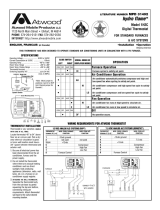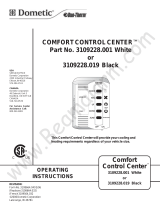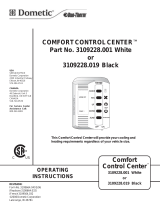Dometic Blizzard NXT Roof Top Unit Used Installation guide
- Category
- Thermostats
- Type
- Installation guide
This manual is also suitable for
Dometic Blizzard NXT Roof Top Unit Used is a powerful air conditioning system designed to provide reliable cooling for recreational vehicles. With a nominal cooling capacity of 13,500 BTU/hr or 15,000 BTU/hr, it efficiently maintains a comfortable temperature inside your RV. The unit operates on 120 Vac, 60 Hz, 1-phase power and requires a minimum wire size of 12 AWG copper. It comes with an electronic control kit, thermostat, and optional indoor temperature sensor for precise temperature management.
Dometic Blizzard NXT Roof Top Unit Used is a powerful air conditioning system designed to provide reliable cooling for recreational vehicles. With a nominal cooling capacity of 13,500 BTU/hr or 15,000 BTU/hr, it efficiently maintains a comfortable temperature inside your RV. The unit operates on 120 Vac, 60 Hz, 1-phase power and requires a minimum wire size of 12 AWG copper. It comes with an electronic control kit, thermostat, and optional indoor temperature sensor for precise temperature management.

















-
 1
1
-
 2
2
-
 3
3
-
 4
4
-
 5
5
-
 6
6
-
 7
7
-
 8
8
-
 9
9
-
 10
10
-
 11
11
-
 12
12
-
 13
13
-
 14
14
-
 15
15
-
 16
16
-
 17
17
Dometic Blizzard NXT Roof Top Unit Used Installation guide
- Category
- Thermostats
- Type
- Installation guide
- This manual is also suitable for
Dometic Blizzard NXT Roof Top Unit Used is a powerful air conditioning system designed to provide reliable cooling for recreational vehicles. With a nominal cooling capacity of 13,500 BTU/hr or 15,000 BTU/hr, it efficiently maintains a comfortable temperature inside your RV. The unit operates on 120 Vac, 60 Hz, 1-phase power and requires a minimum wire size of 12 AWG copper. It comes with an electronic control kit, thermostat, and optional indoor temperature sensor for precise temperature management.
Ask a question and I''ll find the answer in the document
Finding information in a document is now easier with AI
Related papers
-
Dometic Roof top AC Unit 457 and 459_Use Installation guide
-
Dometic CCC 2 LCD SZ 3314850.000 Electronic ADB Brisk Air Penguin HP AMER(en) Operating instructions
-
Dometic 3109311.005 Installation guide
-
Dometic 459146 B59146 3314852.000 Operating instructions
-
Dometic 477915, 477915A, 479516, 479516A Operating instructions
-
Dometic Roof Top Unit 630025.331, 650015.30X, 650015C35X, 650015.80X, 650015C85X Operating instructions
-
Dometic Roof Top Unit Used Installation guide
-
Dometic 489516P, 489516A, 3313189.049, 3314850.000 Installation guide
-
Dometic Roof Top AC_Heat Pump Penguin 600312-600315_630815_used Installation guide
-
Dometic Duo Therm 3106986.007 Cable Adapter Kit Conversion To Comfort Control Center Installation guide
Other documents
-
Voyager Advent Air Owner's manual
-
Voyager Non-Ducted User manual
-
 Atwood Mobile Products 1H2C User manual
Atwood Mobile Products 1H2C User manual
-
 Duo-Therm 3109228.001 Operating Instructions Manual
Duo-Therm 3109228.001 Operating Instructions Manual
-
 Duo-Therm 3109228.001 Operating Instructions Manual
Duo-Therm 3109228.001 Operating Instructions Manual
-
Voyager ACM135 User manual
-
Duo-Therm 600315.326 Installation guide
-
Advent AC135HP Operating instructions
-
Furrion FACR15SA-PS User manual
-
Voyager ACRG User manual



















